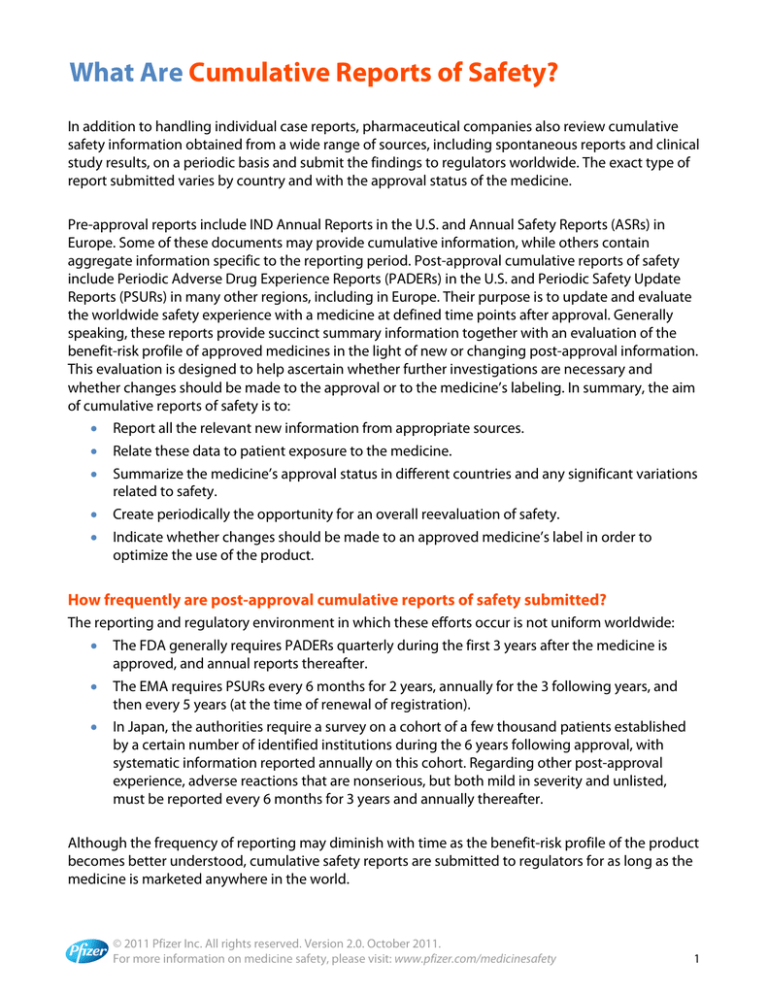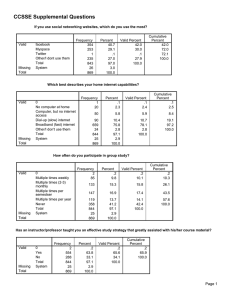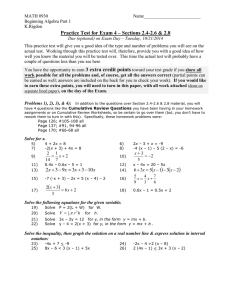
What Are Cumulative Reports of Safety?
In addition to handling individual case reports, pharmaceutical companies also review cumulative
safety information obtained from a wide range of sources, including spontaneous reports and clinical
study results, on a periodic basis and submit the findings to regulators worldwide. The exact type of
report submitted varies by country and with the approval status of the medicine.
Pre-approval reports include IND Annual Reports in the U.S. and Annual Safety Reports (ASRs) in
Europe. Some of these documents may provide cumulative information, while others contain
aggregate information specific to the reporting period. Post-approval cumulative reports of safety
include Periodic Adverse Drug Experience Reports (PADERs) in the U.S. and Periodic Safety Update
Reports (PSURs) in many other regions, including in Europe. Their purpose is to update and evaluate
the worldwide safety experience with a medicine at defined time points after approval. Generally
speaking, these reports provide succinct summary information together with an evaluation of the
benefit-risk profile of approved medicines in the light of new or changing post-approval information.
This evaluation is designed to help ascertain whether further investigations are necessary and
whether changes should be made to the approval or to the medicine’s labeling. In summary, the aim
of cumulative reports of safety is to:
•
Report all the relevant new information from appropriate sources.
•
Relate these data to patient exposure to the medicine.
•
Summarize the medicine’s approval status in different countries and any significant variations
related to safety.
•
Create periodically the opportunity for an overall reevaluation of safety.
•
Indicate whether changes should be made to an approved medicine’s label in order to
optimize the use of the product.
How frequently are post-approval cumulative reports of safety submitted?
The reporting and regulatory environment in which these efforts occur is not uniform worldwide:
•
The FDA generally requires PADERs quarterly during the first 3 years after the medicine is
approved, and annual reports thereafter.
•
The EMA requires PSURs every 6 months for 2 years, annually for the 3 following years, and
then every 5 years (at the time of renewal of registration).
•
In Japan, the authorities require a survey on a cohort of a few thousand patients established
by a certain number of identified institutions during the 6 years following approval, with
systematic information reported annually on this cohort. Regarding other post-approval
experience, adverse reactions that are nonserious, but both mild in severity and unlisted,
must be reported every 6 months for 3 years and annually thereafter.
Although the frequency of reporting may diminish with time as the benefit-risk profile of the product
becomes better understood, cumulative safety reports are submitted to regulators for as long as the
medicine is marketed anywhere in the world.
© 2011 Pfizer Inc. All rights reserved. Version 2.0. October 2011.
For more information on medicine safety, please visit: www.pfizer.com/medicinesafety
1
What Are Cumulative Reports of Safety? (cont’d)
How up-to-date is the information in a cumulative report of safety?
The cumulative safety report will include safety information on all indications, dosage forms, and
regimens of a medicine as of a specific cut-off reporting time point, or data lock point (DLP). In
addition, data on serious, unexpected adverse events are provided for both the period in question
and as cumulative summary tabulations starting from the International Birth Date, or IBD, which is
the date of first approval in any country. In rare circumstances, a pharmaceutical company can make
a special request to the regulatory agency for 30 additional days to submit a cumulative safety
report—for example, when there are:
•
A large number of case reports for the period (and no new significant safety concerns).
•
Issues raised by regulatory agencies in the previous cumulative report for which the company
is preparing additional or further analysis.
•
Issues identified by the company for additional or further analysis.
What do cumulative reports of safety contain?
As noted above, the main focus of a cumulative safety report is serious, unexpected adverse events.
All spontaneously reported adverse events are included in a cumulative safety report. For clinical
study and literature cases, only those judged to be related to the medicine by the reporter and the
pharmaceutical company are typically included. PSURs and Periodic Adverse Drug Experiences
Reports (PADERs) submitted to the FDA differ considerably in terms of content, as shown in the
sidebars below.
Table of Contents for a PSUR
The content and format of a PSUR is specified in the following guidelines from the International
Conference on Harmonisation (ICH), which aims to harmonize regulatory requirements globally:
• Introduction to the product, so that the report “stands alone” but is also placed in perspective
relative to previous reports and circumstances.
• Worldwide approval status (cumulative information, for all countries in which a regulatory
decision about approval has been made) covering:
> Dates of approval/renewal.
> Any qualifications for approval, such as safety-related limits on indications.
> Indications and special populations covered by approvals, if any.
> Lack of approval, including explanation, by regulatory agencies.
> Withdrawal of an application for approval if related to safety or efficacy.
> Launch date(s).
> Trade (brand) name(s).
(cont’d)
© 2011 Pfizer Inc. All rights reserved. Version 2.0. October 2011.
For more information on medicine safety, please visit: www.pfizer.com/medicinesafety
2
What Are Cumulative Reports of Safety? (cont’d)
Table of Contents for a PSUR (cont’d)
•
Update on regulatory agency or pharmaceutical company actions taken for safety reasons,
such as:
>
>
>
>
>
>
>
Approval withdrawal/suspension.
Failure to obtain renewal of approval.
Restrictions on distribution.
Suspension of a clinical study.
Dosage modification.
Changes in target population or indications.
Formulation changes.
•
Changes to reference safety information (e.g., contraindications, precautions, warnings,
adverse events, or drug-drug interactions).
•
Data on patient exposure derived from an estimate of the number of patients exposed, along
with the method used to calculate the estimate.
•
Individual case histories (from literature, spontaneous reports, clinical studies, or other
sources), including:
> Brief description of the criteria used to select cases for presentation.
> Description and analysis of selected cases, including fatalities, presenting new and
relevant safety information and grouped by medically relevant headings or system
organ classes.
> Corresponding line listings/summary tabulations.
•
Discussion of company-sponsored and other studies yielding relevant safety information,
including:
> Newly analyzed completed studies (nonclinical, clinical, epidemiologic) yielding safety
information with potential impact on labeling.
> Targeted new safety studies (planned or in progress).
> Published studies that address safety issues.
•
Other information (such as information relating to efficacy that represents a significant
hazard to the treated population or any kind of important late-breaking information).
•
Overall safety evaluation, with specific highlighting/evaluation of:
>
>
>
>
Change in characteristics of listed reactions (e.g., severity, outcome, target population)
Serious unlisted* reactions, placing cumulative reports into perspective
Nonserious unlisted* reactions
Increased reporting frequency of listed* reactions
*An unlisted reaction is one that is not consistent in nature or severity with the applicable product information
(e.g., the prescribing information for the medicine in the country or region of the regulatory authority to which
the cumulative report of safety is submitted).
(cont’d)
© 2011 Pfizer Inc. All rights reserved. Version 2.0. October 2011.
For more information on medicine safety, please visit: www.pfizer.com/medicinesafety
3
What Are Cumulative Reports of Safety? (cont’d)
Table of Contents for a PSUR (cont’d)
> Any new safety issue (or lack of significant new information) regarding:
⎯ Drug interactions.
⎯ Experience with overdose, deliberate or accidental, and its treatment.
⎯ Drug abuse or misuse.
⎯ Positive or negative experiences during pregnancy or lactation.
⎯ Experience in special patient groups (e.g., children, elderly, organ impaired).
⎯ Effects of long-term treatment.
•
Conclusion.
Table of Contents for a PADER
•
Summary and analysis of the information contained
in the report.
> Analysis of the 15-day reports submitted
during the reporting period.
> Tables of frequency of occurrence of adverse
events from the reporting period, organized by
body system.
•
A MedWatch form for each adverse event* not
previously submitted as a 15-day report.
In addition, pharmaceutical
companies submit NDA Annual
Reports to the FDA. These
contain information from the
preceding year that might impact
safety, efficacy, or labeling, as
well as information on:
•
Labeling changes.
•
Distribution.
•
Chemistry,
manufacturing, and
controls (CM&C) changes.
•
Nonclinical (i.e.,
preclinical) laboratory
studies.
•
Clinical study data.
•
Pediatric data.
> Indexed as a line listing of report numbers and
adverse event terms.
•
Follow-up information for adverse events submitted
in a previous periodic report.
•
Actions taken for safety reasons since the last report.
> For example, studies initiated, changes to
product labeling, or a “Dear Health Care
Professional” letter.
*PADERs do not include adverse events occurring outside the U.S. or
those obtained from the scientific literature or from post-approval
studies, except for 15-day reports. Companies are also encouraged by
the FDA to seek a waiver to exclude MedWatch forms for nonserious
listed adverse events from periodic reports. (A listed reaction is one
that is consistent in nature and severity with the U.S. prescribing
information.)
© 2011 Pfizer Inc. All rights reserved. Version 2.0. October 2011.
For more information on medicine safety, please visit: www.pfizer.com/medicinesafety
4







